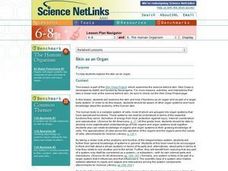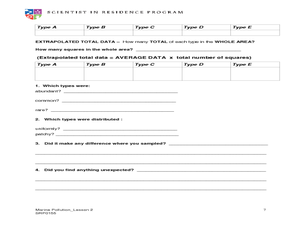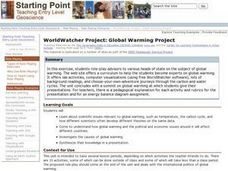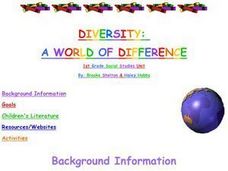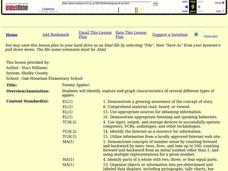Curated OER
Investigating Triangles 1
Students independently investigate the Pythagorean Theorem. They are given a set of triangles that involve whole number Pythagorean Triples. The main focus of the lesson is exploration rather than discovering the Pythagorean Theorem.
Curated OER
Decimal Fractions
Students use rounding and compensating with whole numbers and explain how to use the empty number line to show additions and subtractions. They round and compensate in relation to decimal subtraction
Background
Curated OER
Math: Football League Statistics
Students examine a soccer league final standings chart and then answer 12 questions based on the information provided. They calculate some answers in both fractions and percentages.
Curated OER
Identifying trophic levels and the skeletal system through Owl Pellets
Young scholars identify a food chain sequence. They compare, identify, and record the rodent skeletal parts to a rodent skeletal diagram. Students construct a rodent skeleton from the skeletal parts found in the pellet. They are given...
Curated OER
Lesson Plan on Pidyon Shevuyim: The Redemption of Captives
Students receive instruction on Pidyon Shevuyim in a whole class setting. They work in small groups to read and answer question on the topic, and meet as a class to discuss their findings.
Curated OER
Fractions!
Second graders observe and design manipulatives showing fractional parts. In this fractional part activity, 2nd graders create a paper hamburger using circle fractions. Students navigate a website to find fractional parts of...
Curated OER
Water and Ice
Students make observations of ice as it melts. In this phase change lesson, students observe ice as it melts in a cup. They discuss their observations and place the cup of water into a freezer to change it back into ice.
Curated OER
Skin as an Organ
Young scholars are introduced to human skin as an organ of the body with many roles, functions and interactions with other organs. They investigate the integumentary system in groups and complete a worksheet with their findings.
Curated OER
Scientific Sampling
Students take a sample of fish and try to determine how many fish are in the sea. In this scientific sampling lesson, students explore the way scientists measure large areas of samples. Students record the distribution in a quadrant.
Curated OER
Fractions of a Band
Third graders investigate fractions. In this time lesson plan, 3rd graders determine the amount of time it takes to perform certain tasks.
Curated OER
Original Band Compositions
Students create and perform original band compositions using their own band instruments. This two day lesson requires student compositions to be done at home. Students evaluate performances using a checklist for composing (included).
Curated OER
Cooking With Cuisinaires
Second graders explore fraction with Cuisenaire Rods. In this fraction instructional activity, 2nd graders recieve "recipe" cards for adding fractions. After practicing, students create their own cards then exchange with...
Curated OER
Organ Systems
Students state the name of major body systems, They identify what each system does and list the major organs in each system. In addition, they complete a puzzle matching organ systems to organ function.
Curated OER
Equivalent Decimals
Students develop strategies to find equivalent decimals. In this equivalent decimals activity, students participate in a variety of decimal games to find equivalent decimals.
Curated OER
What is a Fraction
Students explore fractions and define their parts. They define numerator and the denominator and use an apple to model familiar fractions. Using, mini whiteboards, they draw pictures on their white board to describe a given fraction.
Curated OER
Government
Second graders run for various offices. They dress up like a politician, pretend to be running for an office, and tell the students why they should vote for him/her. They explain why it is necessary for a community to have a government
Curated OER
Living and Nonliving Things
Students photograph five objects from a bag and five objects from the outdoors. Students categorize things by living and non-living and by properties such as color, size, structure and needs. Students draw conclusions about the basic...
Curated OER
SEVERE WEATHER UNIT
Young scholars conduct research on specific severe weather patterns of interest and collect data to be shared with other students on these phenomona. They write (or review) a severe weather action plan for the school and presents their...
Curated OER
WorldWatcher Project: Global Warming Project
Students conduct lab activities, computer visualizations, and other various forms of research in preparation for a role-play activity in which they assume the identities of advisors to various heads of state on the subject of global...
Curated OER
Diversity: a World of Difference
First graders each add a different item to a classroom salad while discussing the connection to a multicultural society. They also create a friendship web with yarn by each of them contributing some unique quality about themselves. ...
Curated OER
Picturing a Story
Students view slides from the movie "Hoot" and discuss characters, setting and the caption. They identify where in the rise and fall of the plot this scene takes place. They brainstorm elements needed to create a story from a picture....
Curated OER
Pictures and Slogans Persuade an Audience!
Students understand that writers utilize various techniques to persuade an audience. They develop an awareness of how the media works to persuade them as the consumer. They create a visual representation of various feelings and emotions...
Curated OER
Yummy Apples!
Students discuss apples and how they are grown. They listen as the teacher reads "Apples," by Gail Gibbons. Students discuss the story. They view several different types of apples and compare their characteristics. Students taste several...
Curated OER
Capital for Cookies
Fourth graders find the meaning for capital, land, labor and enterprise and relate them to economics of a place. In this economics instructional activity, 4th graders form a company to make an agricultural product and look for the...







